DIGICGVision

# ऐतिहासिक अनुसंधान पद्धति : अर्थ, परिभाषा, स्त्रोत, प्रमुख चरण, गुण एवं दोष (Historical Method in Hindi)
Table of Contents
ऐतिहासिक अनुसंधान पद्धति :
इतिहास शब्द का उद्गम ‘ Historia ‘ शब्द से हुआ है, जिनका मूल अर्थ होता है सीखना या खोज द्वारा प्राप्त किया गया ज्ञान। प्राचीनकाल में मानव इतिहास के अन्तर्गत भूतकालीन घटनाओं का खोजपूर्ण अध्ययन होता था। एक इतिहासकार का यह कार्य होता है, कि वह भूतकाल की घटनाओं के विषय में सामग्री एकत्रित करे तथा उनकी सही व समुचित व्याख्या करे।
आधुनिक युग में इतिहास के विषय में नया दृष्टिकोण यह है कि यह एक दिये हुए मानव समाज व सांस्कृतिक विशेष की संस्थाओं को दृष्टिगत रखते हुए मानव घटनाओं के विषय में सत्य विवरण प्रदान करे। सत्य तो यह है कि कोई भी घटना सामाजिक शून्य (Social Vacuum) में नहीं होती।

अब ऐतिहासिक पद्धति का उद्देश्य भूतकाल और सामाजिक शक्तियों के विषय में अनुसन्धान कर सिद्धान्तों को निरूपित करना हो गया है। अब यह माना जाने लगा है कि वास्तविक इतिहास में केवल राजों, महाराजों और युद्धों का ही उल्लेख नहीं होना चाहिये, अपितु उन सभी सामाजिक, साँस्कृतिक संस्थाओं और गतिविधियों का उल्लेख तथा सही विवचेन होना चाहिए जिन्होंने भूतकाल में समाज की रचना करने या उसको गतिशील बनाने में प्रयत्क्ष व अप्रत्यक्ष रूप से कार्य किया था।
आधुनिक युग में इस प्रकार के इतिहास के निर्माण के लिए प्रो० टॉयन्बी, रोस्टोटजेब, कोल्टन व जैकोब बरखर्डच (Toynbey, Rostovtzeb, Coulton, Jacob Burkhardt) प्रेरक बने हैं, क्योंकि इनकी यह मान्यता रही है कि इतिहास को मानवीय सम्बन्ध, सामाजिक प्रतिमानों, जनरीतियों व प्रथाओं और समाज की अन्य महत्वपूर्ण संस्थाओं से सम्बन्धित रहना चाहिये। इतिहास व समाजविज्ञान इस समान उपागम के फलस्वरूप अत्यन्त निकट आते जा रहे हैं और समाजविज्ञान में ‘ ऐतिहासिक समाज विज्ञान ‘ (Historical Sociology) नामक अध्ययन शाखा के विकास का जिसके प्रमुख विद्वान सिगमंड व डायमंड विरबाय रोबर्ट बैल्लाह, रेमन्ड आइरन आदि हैं।
स्पष्ट है कि इतिहास अब केवल भूतकालीन किस्से-कहानियों तक ही सीमित नहीं रह गया है, बल्कि आज के वैज्ञानिक युग में इसकी विवरणात्मक प्रकृति को भी विश्लेषण रूप प्रदान किया जा रहा है। अब इसके अन्तर्गत, विभिन्न घटनायें घटित होने की परिस्थितियाँ, उनके परिणाम, सामाजिक, आर्थिक, धार्मिक-सांस्कृतिक तथा राजनैतिक क्षेत्रों में हुए परिवर्तन तथा भविष्य में सम्भव हो सकने वाली रूपरेखा इत्यादि का अध्ययन किया जाने लगा है। लेकिन भूतकालीन समाज के विस्तृत तथा गहन अध्ययन, अतीत के महत्वपूर्ण तथ्यों और घटनाओं, उनके सन्दर्भ में वर्तमान समाज की जानकारी, समाज को प्रभावित करने वाले तत्व या कारक तथा इनके विश्लेषण, इत्यादि के लिये किसी पद्धति की आवश्यकता पड़ती है। यह पद्धति ऐतिहासिक पद्धति ही है। इस पद्धति को परिभाषित करते हुए श्रीमति यंग ने बताया है कि “वह प्रणाली जो ऐसे भूतकालीन सामाजिक तत्वों तथा प्रभावों की, जिन्होंने ‘वर्तमान’ को रूप प्रदान किया है, खोज करके आगमन विधि के आधार पर कुछ सिद्धान्तों का निर्माण करती है, ऐतिहासिक पद्धति मानी जाती है।”
श्रीमती पी. वी. यंग के अनुसार , “ऐतिहासिक पद्धति आगमन के सिद्धांतों के आधार पर अतीत की एवं सामाजिक शक्तियों की खोज है जिन्होंने की वर्तमान को ढाला है।”
ऐतिहासिक पद्धति का अनुकरण करने वाले व्यक्ति को निम्नांकित दोषों से बचने का प्रयास करना चाहिए :
समाजशास्त्रियों का मत है कि ऐतिहासिक पद्धति का अनुकरण करने वाले व्यक्ति को निम्नांकित दोषों से बचने का प्रयास करना चाहिए-
1. अति सरल (Over Simplification) अर्थात् बहुत अधिक सरल सम्बन्धों को ढूँढने व सरल ढंग में तथ्य प्रस्तुत करने का प्रयास करना।
2. अति सामान्यीकरण (Over generalization) अथवा बहुत अधिक सामान्यीकारण की प्रवृत्ति प्रदर्शित करना।
3. पूर्व समय में प्रचलित शब्दों की व्याख्या न कर पाना (Failure to interpret terms prevent in the past)।
4. महत्वपूर्ण व अमहत्वपूर्ण तथ्यों के बीच अन्तर न कर पाना (Failure to distinguish between significant and insignificant facts)।
5. कल्पनात्मक इतिहास (Conjunctural History) बनाने का प्रयास करना।
ऐतिहासिक सामग्री के स्रोत :
ऐतिहासिक पद्धति की द्वारा किसी अध्ययन को पूर्ण करने की दृष्टि से जिस सामग्री की आवश्यकता पड़ती है, उसे कुछ स्रोतों से प्राप्त करना पड़ता है।
श्रीमती यंग ने ऐतिहासिक स्रोतों को तीन भागों में विभाजित किया है-
1. इतिहासकार की पहुँच के भीतर प्राप्त प्रलेख तथा विवधि सामग्री
प्रथम श्रेणी के अन्तर्गत प्राप्त होने वाले प्रलेखों में वेद, पुराण, स्मृतियाँ, उपनिषद् इत्यादि ग्रंथ सम्मिलित किये जा सकते हैं तथा खुदाई के फलस्वरूप प्राप्त वस्तुएं, अजन्ता, एलोरा तथा खजुराहो इत्यादि की गुफाओं के लेख भी महत्वपूर्ण स्रोत बन सकते हैं।
2. साँस्कृतिक इतिहास तथा विश्लेषण इतिहास सामग्री
द्वितीय श्रेणी के अन्तर्गत् सांस्कृतिक य विश्लेषणात्मक इतिहास किसी भी काल या युग में किसी समाज की सांस्कृतिक स्थिति का बोध कराता है तथ उसके विभिन्न साँस्कृतिक तत्वों के स्वरूप एवं उनमें विकास तथा परिवर्तन की ओर ध्यान दिलाता है।
3. विश्वसनीय अवलोकन कर्त्ताओं तथा गवाहों के निजी स्रोत
तृतीय श्रेणी के अन्तर्गत, समय-समय पर व्यक्तिगत इतिहासकारों ने अपनी यात्राओं या पर्यटनों द्वारा जो अवलोकन या निरीक्षण किये हैं और ऐतिहासिक विवरणों के रूप में प्रस्तुत किये हैं, ऐसी सामग्री को सम्मिलित किया जा सकता है।
इस प्रकार की सूचनायें या सामग्री हमें आज भी भारत सरकार के पुरातत्व विभाग के अधीन या विभिन्न राज्यों के संग्रहालयों में देखने तथा अध्ययन करने को उपलब्ध हो सकती हैं। यही कारण है कि प्रायः ऐतिहासिक पद्धति को ही संग्रहालय पद्धति के नाम से जाना जाता है।
ऐतिहासिक पद्धति के चरण :
ऐतिहासिक पद्धति के निम्नांकित चरण हैं जिनका संक्षिप्त विवरण प्रस्तुत है-
1. समस्या का चुनाव अध्ययन
समस्या इस प्रकार की होनी चाहिए जिससे भूतकालीन समाज के वास्तविक स्वरूप को यथासम्भव यथार्थ रूप से समझा जाना आवश्यक हो तथा उसके आधार पर वर्तमान दशाओं तथा उनमें हुए परिवर्तनों को ज्ञात किया जा सके और भविष्य की प्रवृत्ति का अनुमान लगाना सम्भव हो। उस पर लगने वाले समय, धन व स्वयं की लागत का सही अनुमान लगाने के उपरान्त ही किसी समस्या को चुना जा सकता है।
2. तथ्य संकलन
तथ्यों के संकलन में उनकी प्रकृति तथा उपलब्ध स्रोतों पर विशेष ध्यान देना पड़ता है। अध्ययनकर्त्ता की अपने योग्यता, प्रशिक्षण तथा अनुभव भी उसकी कुशलता में सहायक होते हैं। सरकारी तथा गैर सरकारी प्रलेखों का उचित प्रकार से प्रयोग किया जाना चाहिए। अनावश्यक सामग्री की छटनी कर देनी चहिए।
3. ऐतिहासिक आलोचना
बाह्य आलोचना का अर्थ है कि जो भी प्राथमिक या द्वितीय स्रोत उपलब्ध हो पाये हैं उनकी प्रमाणिकता अथवा वास्तविकता की जाँच की जाये कि कही सामग्री झूठी या जाली तो नहीं है। आन्तरिक आलोचना के अन्तर्गत यह देखना आवश्यक होता है कि किसी भी स्रोत का लेखक कितना सच्चा रहा है? क्या उसने किसी पक्षपात् अभिनति या अज्ञान के वशीभूत होकर तो नहीं लिखा है? क्या उसने घटना विशेष के घटित होते ही लिखा है या बाद में, उसके सूचनादाता कौन रहे हैं और किस प्रकार उसको सूचना प्राप्त हुई और कहाँ तक सूचना को सार्थक माना जाना चाहिये?
4. साम्रगी की व्याख्या
संकलित की गई सामग्री की उपयुक्त आलोचना के उपरान्त उसकी व्याख्या का चरण आता है। अध्ययनकर्त्ता किन-किन तथ्यों के आधार पर किन-किन निष्कर्षो पर पहुँचता है, यह स्पष्टतः बतलाना होता है। इस प्रकार की व्याख्या करने के लिये अध्ययनकर्त्ता को बहुत ही कुशलता व बारीकी से कार्य करना पड़ता है।
5. प्रतिवेदन निर्माण
प्रतिवेदन के निर्माण में अध्ययनकर्ता को ठीक उसी प्रकार कार्य करना होता है। जैसे कि समाजशास्त्र का कोई भी अध्ययनकर्त्ता अपने अध्ययन के प्रतिवेदन को बनाने में करता है। प्रतिवेदन में उपयुक्त शीर्षकों को तथा अनुच्छेदों के अन्तर्गत सामग्री को आकर्षित ढंग से प्रस्तुत करना चाहिये। लिखने की शैली सरल, स्पष्ट, रोचक व वस्तुनिष्ठ होनी चाहिये। सभी महत्वपूर्ण सामग्री, अन्य व्यक्तियों के महत्वपूर्ण कथन आदि को संलग्न पत्रों के रूप में लगाना चाहिये। आवश्यक प्रालेख, रेखाचित्र, मानचित्र, फोटोग्राफ आदि को भी उचित ढंग से लगाना चाहिये।
ऐतिहासिक पद्धति के गुण :
ऐतिहासिक पद्धति समाजशास्त्र की एक विशिष्ट एवं उपयोगी पद्धति है। इस पद्धति के प्रयोग के महत्व को निम्नलिखित रूप में समझा जा सकता है-
1. परिवर्तन के स्वरूप को जानना
ऐतिहासिक पद्धति से हमें यह भी ज्ञान प्राप्त होता है कि समाज एवं संस्कृति में समय-समय पर कौन-कौन से परिवर्तन होते हैं, कौन-कौन सी घटनायें घटित होती रही हैं तथा उनका वर्तमान स्वरूप क्या है? वस्तुतः यह पद्धति परिवर्तन एवं विकास की प्रकृति की ओर संकेत करती है एवं कार्य कारण सम्बन्ध भी स्थापित करती है।
2. भूतकाल के महत्व को जानना
इतिहास को भूतकालीन अनुभवों तथा वर्तमान मनोवृत्तियों एवं मूल्यों के मध्य सम्बन्ध स्थापित करने वाली श्रृंखला माना जा सकता है। इससे हम अतीत की परम्पराओं, प्रथाओं, रीति-रिवाजों, आदर्शों एवं मूल्यों तथा संस्थाओं आदि की जानकारी प्राप्त कर लेते हैं। ऐतिहासिक पद्धति से प्रत्येक लम्बे इतिहास वाले समाज की सही जानकारी प्राप्त होती है।
3. उपकल्पनाओं का निर्माण
यह विधि उपकल्पनाओं का भी स्रोत हैं। जब एक अध्ययनकर्त्ता अध्ययन की जा रही घटना के सन्दर्भ में ऐतिहासिक सामग्री का संकलन करता है तो उसे अनेक नवीन तथ्यों का विभिन्न तथ्यों में सम्बन्धों का पता चलता है, जिसके आधार पर वह उपकल्पनाओं का निर्माण करता है।
4. वर्तमान समाज को समझना
इस पद्धति से हमें उन सामाजिक शक्तियों का परिचय प्राप्त होता है जो समाज के वर्तमान स्वरूप को अतीत पर आधारित करती हैं। दूसरे शब्दों में यह पद्धति अतीत के माध्यम से वर्तमान को समझने में लाभदायक होती हैं।
5. इतिहास की व्यावहारिक उपयोगिता
ऐतिहासिक पद्धति की सामग्री सामाजिक स्थितियों, मानव समस्याओं तथा उनके विकास एवं वर्तमान स्थिति के जानने के लिये भी उपयोगी सिद्ध होती है। यह समाज के पुनर्निर्माण के लिये, वर्तमान समस्याओं पर इसका प्रभाव देखने और इनके सुधारों की आवश्यकता जानने हेतु तथा सामाजिक नियोजन एवं उन्नति हेतु बुद्धिमत्तापूर्ण आधार बनाती है।
6. द्वैतीयक स्रोत के रूप में
वस्तुतः ऐतिहासिक प्रलेख केवल कुछ पीढ़ियों तक ही नहीं, वरन् कितनी ही शताब्दियों तक की घटनाओं को प्रदर्शित करते हैं। ये अधिकांश रूप में सामाजिक शोध के विद्यार्थियों को द्वैतीयक सूचनाओं के प्रयोग करने में, जो इतिहास की ही एक व्याख्या है, सहायक होते हैं।
ऐतिहासिक पद्धति के दोष :
ऐतिहासिक पद्धति उपयोगी होते हुये भी प्रायः अनुपयुक्त पाई जाती है। इसके प्रमुख दोष निम्नांकित है –
1. बिखरे हुये प्रलेख
इस विधि के अर्न्तगत अध्ययन हेतु जो सामग्री चाहिये, वह प्रायः एक साथ एक ही स्थान पर नहीं मिल पाती। इन आवश्यक तथ्यों को बिखरे हुये स्थानों से एकत्रित करने में अधिक समय व धन व्यय होता है। इस सबके बावजूद भी पूर्ण सामग्री उपलब्ध नहीं हो पाती है।
2. सत्यापन की कठिनाई
इस विधि के माध्यम से अतीत की घटनाओं की जांच या उनका सत्यापन करना भी कठिन होता है। श्रीमती यंग के अनुसार, “अनुसंधाकर्त्ता समस्त ऐसी ऐतिहासिक सामग्री का जो सामाजिक स्थितियों तथा संस्थाओं का निर्माण करती है परीक्षण और जाँच नहीं करता है। ज्यादा से ज्यादा, वह केवल कुछ ऐसी घटनाओं का अध्ययन कर सकता है जो उसके अध्ययन के अन्तर्गत विश्वासों, व्यवहार प्रतिमानों तथा प्रथाओं से सम्बन्धित हैं।”
3. घटनाओं की पुरावृत्ति असम्भव
इस विधि के अन्तर्गत जिन घटनाओं एवं तथ्यों का अध्ययन किया जाता है, वे सभी अतीत से सम्बन्धित होते हैं। अध्ययनकर्त्ता को इनके अध्ययन की सहायतार्थ द्वैतीयक सामग्री, प्रलेख व रिकार्ड आदि पर निर्भर रहना पड़ता है। उसके समक्ष उक्त घटनाओं की पुनरावृत्ति भी असम्भव होती है।
4. विश्वसनीयता की समस्या
वस्तुतः स्वयं इतिहासकारों को एक ही स्थान तथा समय पर घटित होने वाली समस्त घटनाओं की पूर्ण जानकारी नहीं होती। फिर इतिहासकार ऐसी बहुत सी बातें भी छोड़ देते हैं, जो समाजशास्त्री के लिये बहुत आवश्यक हो सकती हैं। ऐतिहासिक तथ्य जिन स्रोतों से एकत्रित किये जाते हैं, उनके संकलन-कर्त्ताओं के प्रति भी पूर्ण विश्वसनीयता उत्पन्न नहीं हो पाती।
5. केवल वर्णनात्मक अध्ययन
इस विधि के अन्तर्गत केवल घटनाओं का वर्णन ही किया जा सकता है, विश्लेषण नहीं। लेकिन हम देखते हैं कि आधुनिक युग में समाजशास्त्र में वर्णनात्मक अध्ययनों की महत्ता निरन्तर कम होती जा रही है। इस विधि द्वारा हम गणनात्मक आंकड़ों का संकलन नहीं कर सकते।
6. ऐतिहासिक सामग्री के संकलन में कठिनाई
अतीत की घटनाओं से सम्बन्धित होने के कारण अनेक बार ऐतिहासिक सामग्री भी सरलतापूर्वक उपलब्ध नहीं हो पाती है। बहुत से सरकारी एवं गैर-सरकारी दस्तावेज ऐसे होते हैं जिन्हें अनुसन्धानकर्त्ता नहीं देख सकता।
7. सैद्धान्तिक नियमों की स्थापना सम्भव नहीं
मात्र विशिष्ट घटनाओं के अध्ययन में सहायक होने के कारण यह विधि सैद्धान्तिक नियमों की स्थापना करने में असमर्थ है। इस विधि के अन्तर्गत क्योकि ऐतिहासिक सामग्री की प्रामाणिकता की जाँच करनी कठिन होती है, अतः सैद्धान्तिक नियमों के निर्माण में इससे भी बाधा पड़ती है।
8. सुरक्षा का दोषपूर्ण होना
यह सही है कि पुरातत्व विभाग के अभिलेखागार प्रलेखों तथा रेकार्ड को पर्याप्त मात्रा में संकलित करते हैं, प्रायः इस संकलित सामग्री का अत्यन्त लापरवाही से रखा जाता है, जिसका परिणाम यह होता है कि दीमक, चूहों तथा नमी आदि से उक्त सामग्री की बहुत हानि हो जाती है। अधिक पुराने होने पर ये गल जाते हैं।
Leave a Comment Cancel reply
Save my name, email, and website in this browser for the next time I comment.
Please enter an answer in digits: one × 3 =
- My Account |
- StudentHome |
- TutorHome |
- IntranetHome |
- Contact the OU Contact the OU Contact the OU |
- Accessibility Accessibility
Postgraduate
- International
- News & media
- Business & apprenticeships
Faculty of Arts and Social Sciences

You are here
- School of Arts & Humanities
- Postgraduate Research
Preparing a History PhD proposal
The carefully thought-out and detailed research proposal to be submitted with the formal application is the product of a sometimes prolonged negotiation with your potential supervisor. The supervisor may be enthusiastic about your project or might advise you to consider a different subject or change your angle on it; they may query aspects of your plan such as its breadth, the availability of primary sources or the extent to which you are familiar with the secondary literature. You may be asked to demonstrate the originality of your research question or be advised to consider applying to another institution which may have more appropriate expertise. During this process you will likely be asked to submit a specimen of written-up historical research, such as your Masters or BA dissertation. The sooner you start developing the structure that is expected in a research proposal, the more productive your exchanges with your potential supervisor will be.
You may find different advice for writing a research proposal across different OU webpages. Given that a research proposal can vary significantly across different disciplines, when applying to the History Department you should follow the guidance provided here.
The research proposal you submit in January should be approximately 1000 words, plus a bibliography, and should contain the following:
A title, possibly with a subtitle
The title should not take the form of a question and it may run to a dozen words or more. Like the title of a book, it should clearly convey the topic you propose to work on. A subtitle may explain the chronological or geographical focus of your work, or the methodological approach you will take. Choosing a title is a good way for focusing on the topic you want to investigate and the approach you want to take.
These are examples of poor titles and topics to research:
- Captain Cook’s Third Voyage
- Women in eighteenth-century England
These would be poor topics to research because they lack a strong question and it is not clear which approach they take to their already well-researched subjects. They are generic or merely descriptive.
Examples of good research topics
- Constructing the Eternal City: visual representations of Rome, 1500-1700
- Rearing citizens for the state: manuals for parents in France, 1900-1950
These projects combine a sharp chronological and geographical focus with a clear indication of how the sources will be analysed to respond to a precise question. In the first case, for example, the premise is that visual representations are critical in the making of a city’s eminence. This indicates the type of sources that will be analysed (paintings, engravings and other visual sources). The chronology is particularly well chosen because in these two centuries Rome turned from being the capital of the Catholic world to becoming the much sought-after destination of the Grand Tour; interesting questions of change and continuity come into focus.
Brief summary of your argument
An acceptable PhD thesis must have a central argument, a 'thesis'. You need to have something to argue for or against, a point to prove or disprove, a question to answer. What goes into this section of the proposal is a statement of your question and the answer you plan to give, even if, for now, it remains a hypothesis.
Why this subject is important
We expect originality in a thesis and so under this rubric we expect you to explain why the knowledge you seek on the subject you propose to work on is important for its period and place, or for historians’ views on its period and place. Finding some early-modern English laundry lists would not suffice on its own to justify writing a PhD thesis about them. But those laundry lists could be important evidence for a thesis about the spread of the Great Plague in London, for example.
Framing your research
Your proposal has to show awareness of other scholarly writing on the subject. This section positions your approach to the subject in relation to approaches in some of those works, summarising how far you think it differs. For instance, you could challenge existing interpretations of the end the Cold War, or you might want to support one historian or another; you could open up a neglected aspect of the debate - say by considering the role of an overlooked group or national government - and perhaps kick-start a debate of your own. All this is to show that you have read into your subject and familiarised yourself with its contours. We don’t expect you to have done all your research at the start, but it is essential for you to show familiarity with the key texts and main authors in your chosen field.
What sources might you need to consult in libraries and archives?
Here you should describe or at least list the primary materials you are likely to use in researching your thesis. This demonstrates your confidence that enough relevant sources exist to support a sustained scholarly argument. Many archival catalogues are available online and can be searched remotely, including The National Archives, the National Archives of Scotland, the National Archives (Ireland), the Public Record Office of Northern Ireland and Archives Wales. You can search the London-based Historical Manuscripts Commission and the National Register of Archives, both of which provide access to local county record offices. Databases such as ‘Eighteenth Century Collections Online’ and the British Library’s ‘British Newspapers Online 1600-1900’ will help you identify and locate relevant sources.
What skills are required to work on the sources you plan to use?
You need to show that you have the linguistic competence to pursue your research. With few exceptions, original sources must be read in the original languages; if the principal historical literature is not in English, you must be able to read it too. Palaeographic problems aren’t confined to ancient writing. You might have to tackle early modern or other scripts that are hard to decipher. Even with fluent German, an applicant baffled by the Gothic script and typeface would flounder without undertaking ancillary study. Training is available at The Open University, or in some circumstances you can be funded to undertake training elsewhere, and you should demonstrate awareness of the skills that you need to acquire.
Do you have the technical competence to handle any data-analysis your thesis may require?
Databases, statistical evidence and spreadsheets are used increasingly by historians in certain fields. If your research involves, say, demographic or economic data, you will need to consider whether you have the necessary IT and statistical skills and, if not, how you will acquire them.
How will you arrange access to the libraries and archives where you need to work?
Although primary sources are increasingly available in digitised form, you should consider that important sources may be closed or in private hands. To consult them may require some travelling and so you should be realistic as to what you will be able to do, particularly if you are applying to study part-time as not all archives are open out of regular office hours.
A bibliography
This should come at the end and include a list of the primary sources you plan to use and the relevant secondary literature on the subject. While you should show that you are on top of recent work (and of important older studies) on the topic, there is no point in having a long list of works only marginally related to your subject. As always, specificity is the best policy.
Please follow this link to see an example of a successful research proposal [PDF].
All this may seem daunting, as if the department is asking you to write a thesis before you apply. But that is not our intention; the advice is to help you perform the necessary spadework before entering the formal application process. Working up a proposal under the headings suggested above will, if your application is successful, save you and your supervisor(s) much time if and when the real work begins.
- Study with Us
- News (OU History Blog)

- @history_ou
Request your prospectus
Explore our qualifications and courses by requesting one of our prospectuses today.
Request prospectus
Are you already an OU student?
Go to StudentHome
The Open University
- Study with us
- Supported distance learning
- Funding your studies
- International students
- Global reputation
- Apprenticeships
- Develop your workforce
- Contact the OU
Undergraduate
- Arts and Humanities
- Art History
- Business and Management
- Combined Studies
- Computing and IT
- Counselling
- Creative Writing
- Criminology
- Early Years
- Electronic Engineering
- Engineering
- Environment
- Film and Media
- Health and Social Care
- Health and Wellbeing
- Health Sciences
- International Studies
- Mathematics
- Mental Health
- Nursing and Healthcare
- Religious Studies
- Social Sciences
- Social Work
- Software Engineering
- Sport and Fitness
- Postgraduate study
- Research degrees
- Masters in Art History (MA)
- Masters in Computing (MSc)
- Masters in Creative Writing (MA)
- Masters degree in Education
- Masters in Engineering (MSc)
- Masters in English Literature (MA)
- Masters in History (MA)
- Master of Laws (LLM)
- Masters in Mathematics (MSc)
- Masters in Psychology (MSc)
- A to Z of Masters degrees
- Accessibility statement
- Conditions of use
- Privacy policy
- Cookie policy
- Manage cookie preferences
- Modern slavery act (pdf 149kb)
Follow us on Social media
- Student Policies and Regulations
- Student Charter
- System Status
- Contact the OU Contact the OU
- Modern Slavery Act (pdf 149kb)
© . . .

[100+Pdf] Research Topics Of History In Hindi-इतिहास के शोध विषय
क्या आप इतिहास के लिए शोध विषय खोज रहे हैं, इतिहास शोध पत्र के लिए विषय, छात्रों के लिए इतिहास अनुसंधान विषय, इतिहास के लिए अनुसंधान विषय विचार, पीएचडी के लिए इतिहास अनुसंधान विषय। तो आप सही जगह पर हैं।
इस वेबसाइट पर आप कॉलेज के छात्रों, पीएचडी, एमफिल, शोध प्रबंध, थीसिस, परियोजना, प्रस्तुति, संगोष्ठी या कार्यशाला के लिए बहुत सारे इतिहास अनुसंधान विषय मिलेगे।
इस लेख में हम आपको पूर्ण पीएचडी थीसिस के साथ पीडीऍफ़ में इतिहास के लिए नवीनतम शोध विषय प्रदान करेगे। इतिहास के इन शोध विषयों से आप अपने शोध कार्य के लिए विचार प्राप्त कर सकते हैं। यहाँ पे कॉलेज के छात्रों, पीएचडी, एमफिल, शोध प्रबंध, थीसिस, परियोजना, प्रस्तुति, संगोष्ठी या कार्यशाला के लिए बहुत सारे इतिहास अनुसंधान विषय मिलेगे।
नीचे दिए गए सुझावों की जाँच करें तो आपको इतिहास के लिए सही शोध विषयों को चुनने में आपको मदद मिलेगी: आप दिए गए लिंक से इतिहास अनुसंधान पीएचडी थीसिस को पीडीएफ में भी मुफ्त डाउनलोड कर सकते हैं।
Table of Contents
अब 100+ इतिहास अनुसंधान विषय सूची की जाँच करें
इतिहास 2023 के लिए अनुसंधान विषय, शोध प्रबंध के लिए इतिहास अनुसंधान विषय, इतिहास के लिए अनुसंधान विषय विचार, कॉलेज के छात्रों के लिए इतिहास अनुसंधान विषय विचार, इतिहास अनुसंधान पत्र के लिए विषय, थीसिस के लिए इतिहास अनुसंधान विषय, छात्रों के लिए इतिहास अनुसंधान विषय, स्नातक छात्रों के लिए इतिहास अनुसंधान विषय, विश्वविद्यालय के छात्रों के लिए इतिहास अनुसंधान विषय, पीएचडी के लिए इतिहास अनुसंधान विषय, इतिहास में पीएचडी के लिए अनुसंधान विषय.
एमफिल इतिहास के लिए अनुसंधान विषय
इतिहास पीएचडी विषय
इतिहास के लिए रिसर्च पेपर विषय, इतिहास अनुसंधान पत्र विषय, इतिहास के लिए पीएचडी थीसिस विषय, इतिहास विषय के लिए अनुसंधान विषय, मत्स्य पालन के लिए इतिहास अनुसंधान विषय, इतिहास के लिए अनुसंधान विषय, इतिहास अनुसंधान विषय उदाहरण.
नोट: इस वेबसाइट पर सभी शोध कार्य आइडिया शोधगंगा से प्रेरित हैं: भारतीय शोध का एक भंडार। हम आपको क्रिएटिव कॉमन्स लाइसेंस के तहत अधिकतर शोध कार्य प्रदान करते हैं। इसका श्रेय https://shodhganga.inflibnet.ac.in/ को जाता है। अगर आपको इस वेबसाइट पर कोई कॉपीराइट सामग्री मिलती है और आपको कोई आपत्ति है तो कृपया हमें तुरंत [email protected] पर कनेक्ट करें। हम उस सामग्री को जल्द से जल्द हटा देंगे। यह पोस्ट इसके लिए भी सहायक है: इतिहास थीसिस पीडीएफ, इतिहास थीसिस विषय, इतिहास निबंध विषय, इतिहास थीसिस, इतिहास के लिए आकर्षक शीर्षक, इतिहास के लिए पीएचडी थीसिस विषय, इतिहास शोध पत्र विषय, इतिहास पीएचडी विषय, इतिहास अनुसंधान विषय, “इतिहास अनुसंधान विषय “कॉलेज के छात्रों के लिए।
5 thoughts on “[100+Pdf] Research Topics Of History In Hindi-इतिहास के शोध विषय”
- Pingback: Home - Research Scholar
- Pingback: Home Page 3 - Research Scholar
- Pingback: How To Do Research in Social Science 2023 - Research Scholar
- Pingback: How To Do Research in Mathematics 2023 - Research Scholar
- Pingback: How To Do Research in Library And Information Sciences 2023 - Research Scholar
Leave a Comment Cancel reply
Save my name, email, and website in this browser for the next time I comment.
Shodhganga Mirror Site https://sg.inflibnet.ac.in
- University Coordinator
- Administrator
- User Registration
- Universities & Departments
- Upload Date
- Researcher/Guide
- User Guide and Tutorial
- APS Video & Guide
- Download MoU
- Download MoU for INI
- Shodhganga User
PG Dissertations
Repository of Research in Progress/Synopses MRPs / PDFs / Emeritus Fellowship
The word “Shodh” originates from Sanskrit and stands for “research and discovery”. “Gangotri” is one of the largest glaciers in the Himalayas and the source of origination of the Ganges, the holiest, longest, and largest of rivers in India. The Ganges is the symbol of age-long culture, civilization, ever-aging, ever-flowing, ever-loving, and loved by its people.
Under the initiative called “ShodhGangotri”, research scholars/research supervisors in universities are requested to deposit an electronic version of the approved synopsis submitted by research scholars to the universities for registering themselves for the Ph.D. programme now it is expanded to MRPs/PDFs/Emeritus Fellowship, etc. The repository on one hand would reveal the trends and directions of research being conducted in Indian universities, on the other hand, it would avoid duplication of research. Synopsis in “ShodhGangotri” would later be mapped to full-text theses in "ShodhGanga". As such, once the full-text thesis is submitted for a synopsis, a link to the full-text theses would be provided from ShodhGangotri to "ShodhGanga".
- Latest Updates
Appreciation letter from the Ministry of Ayush regarding the creation of "Ministry of Ayush" under the category "PG Dissertation" into the Shodhgangotri Portal.
Notification Title
121 Universities/Institutes are contributing the Synopses to the Shodhgangotri. [Read More] -->
23 Universities have submitted Post Doctorate fellowships (PDFs),14 Universities have submitted Major-Minor Research Projects (MRPs) and 5 Universities have submitted Emeritus fellowships to the Shodhgangotri.
Contact Us:
General / Technical Query
Email: shodhgangotri[at]inflibnet.ac.in
Phone: 079-2326-8228 / 8232
- Universities Contributed in Shodhgangotri
Swami Ramanand Teerth Marathwada University 3576
Shri jagdishprasad jhabarmal tibrewala university 3500, dayalbagh educational institute 1184, jayoti vidyapeeth womens university 445, mangalore university 379, mahatma gandhi university 369, the iis university 342, visva bharti university 294, pandit ravishankar shukla university 215, maharshi dayanand saraswati university 201, manav rachna international institute of research and studies 183, veer narmad south gujarat university 154, karnataka state womens university 143, iimt university, meerut 136, mody university of science and technology 123, kalasalingam university 119, meenakshi academy of higher education and research 104, ranchi university 103, presidency university, west bengal 98, himachal pradesh university 93, raffles university 93, avinashilingam deemed university for women 91, dr. babasaheb ambedkar marathwada university 88, jaypee university of information technology, solan 82, manav rachna university 82, career point university 74, andhra university 73, rama university uttar pradesh 73, christ university 71, symbiosis international university 59, narsee monjee institute of management studies 59, desh bhagat university 58, abhilashi university 55, dev sanskriti vishwavidyalaya 48, lovely professional university 47, shri vaishnav vidyapeeth vishwavidyalaya 46, jk lakshmipat university 46, 02_post doctorate fellowship 46, maharishi markandeshwar university 40, karnavati university 37, jecrc university 36, vivekananda global university 33, baba ghulam shah badshah university 30, chaudhary devi lal university 29, 01_major-minor research project 26, central university of kashmir 23, ims unison university 21, institute of advanced studies in education(iase) 20, shivaji university 20, xim university 20, delhi pharmaceutical sciences & research university 19, university of calicut 19, lingayas university 19, arni university 18, eternal university 18, icfai university, dehradun 17, sri balaji vidyapeeth 17, a p goyal shimla university 16, chitkara university 15, icfai university, jaipur 15, sardar patel university, balaghat 15, swami rama himalayan university 14, maharaja ranjit singh punjab technical university 13, mandsaur university 10, dr. shyama prasad mukherjee international institute of information technology naya raipur 9, shyam university 9, siksha 'o' anusandhan university 9, bodoland university 9, the west bengal national university of juridical sciences 9, kushabhau thakre patrakarita avam jansanchar vishwavidyalaya 8, jharkhand rai university 8, jaypee institute of information technology 7, sri krishnadevaraya university 7, sree sankaracharya university of sanskrit 7, mahatma gandhi university, nalgonda 6, iec university 6, rajiv gandhi university 6, chaudhary charan singh university 6, kavikulaguru kalidas sanskrit university 5, 04_pg dissertations 5, kuvempu university 5, 03_emeritus fellowship 5, amrita vishwa vidyapeetham (university) 5, madurai kamraj university 5, aryabhatta knowledge university 5, swami vivekanad subharti university 5, tumkur university 4, dr. harisingh gour vishwavidhyalay 4, baddi university of emerging sciences & technology 4, bahra university 3, maulana azad national urdu university 3, jamia milia islamia university 3, madan mohan malaviya university of technology 3, sri sai university 2, srm university, sikkim 2, awadhesh pratap singh university 2, university of kerala 2, rashtrasant tukadoji maharaj nagpur university 2, gujarat university 2, sri devaraj urs university 2, saurashtra university 2, datta meghe institute of medical sciences 1, acharya nagarjuna university 1, mgm university, aurangabad 1, deendayal upadhyaya university 1, anna university 1, opjs university 1, berhampur university 1, sri venkateswara university 1, patna university 1, jiwaji university 1, bharathidasan university 1, mahatma gandhi antarrashtriya hindi vishwavidyalaya 1, bharati vidyapeeth deemed university 1, tamil university 1, test university for user 1, dr. d.y. patil vidyapeeth 1, indian institute of technology kharagpur (iit- kharagpur) 1, rimt university 1, babu banarasi das university, lucknow 1, university of delhi 1, jain university 1, university of patanjali 1, v. b. s. purvanchal university 1, savitribai phule pune university 1, cmr university 1, manipur university 1, manonmaniam sundaranar university 1, about shodhshuddhi.
Based on the recommendation of Sub-Committee, National Steering Committee (NSC) of e-ShodhSindhu, The Ministry of Education, Govt. of India has initiated a programme "ShodhShuddhi" which provides access to Plagiarism Detection Software (PDS) to all universities/Institutions in India since Sept 1, 2019 [Read More...]
Under this initiative, URKUND a Web Based Plagiarism Detection Software system is being provided to all users of universities/Intuitions in the country. This initiative is formally launched by Honorable Minister of HRD (now renamed as Minister of Education) on September 21, 2019
The INFLIBNET Centre receives numerous queries from Colleges regarding membership to Shodhganga and e-ShodhSindhu. Following clarifications are being provided in this regard: Read More.
Sh. Manoj Kumar K
Antiplagiarism query, important links, mou with universities, mou with cfti, ugc notification, m.phil/ph.d regulation 2009.
The Shodhganga@INFLIBNET Centre provides a platform for research students to deposit their Ph.D. theses and make it available to the entire scholarly community in open access. The repository has the ability to capture, index, store, disseminate and preserve ETDs submitted by the researchers. [Read l]
38+ SAMPLE History Proposal in PDF | MS Word
History proposal | ms word, 38+ sample history proposal, what is a history proposal, ideas for a history proposal, tips to read history better, how to create a history proposal, how do you write a history proposal, what should a history research proposal include, what are the main sources of historical research.

History Thesis Proposal
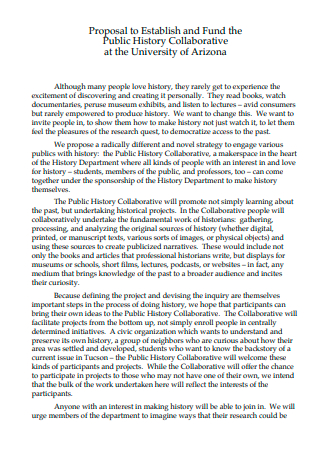
Public History Collaborative Proposal
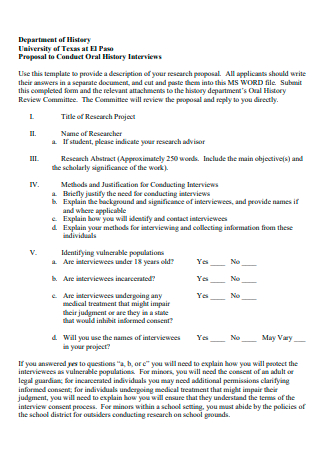
Department of History Proposal
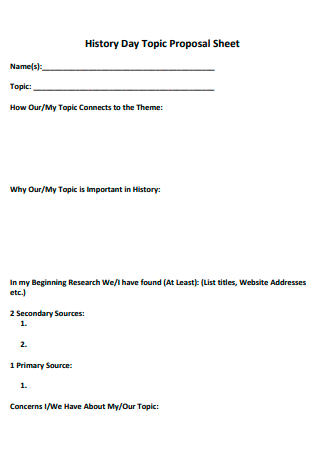
History Day Topic Proposal Sheet
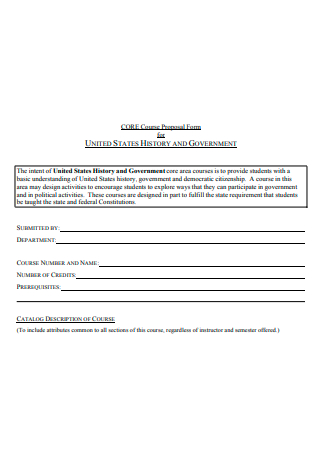
History and Government Course Proposal Form
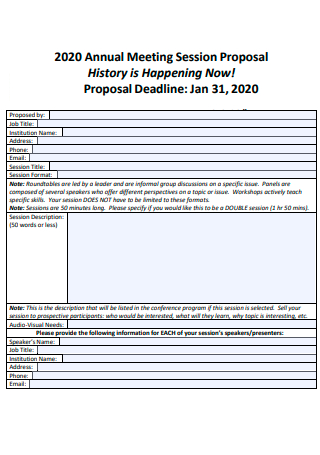
History Annual Meeting Session Proposal
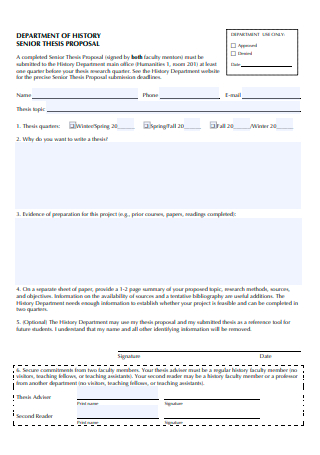
Depatrtment of History Senior Thesis Proposal
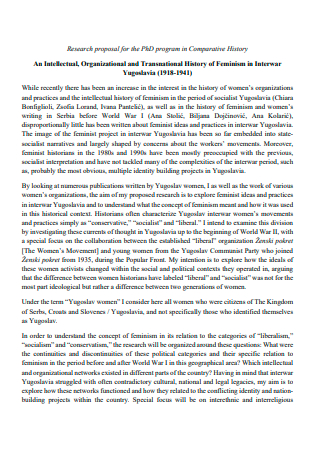
Comparative History Research Proposal
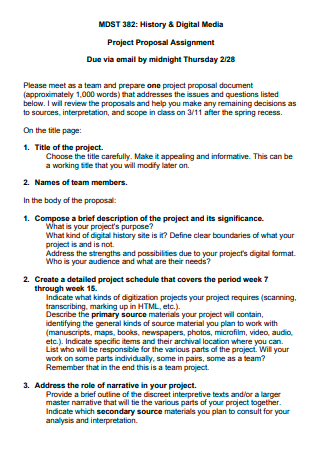

History and Digital Media Project Proposal Assignment
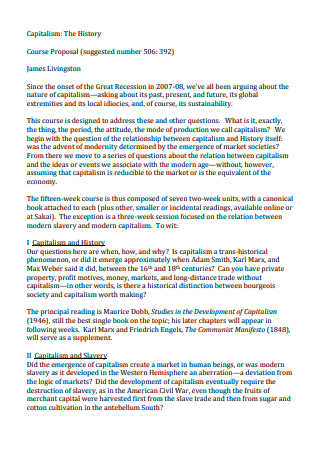
History Course Proposal
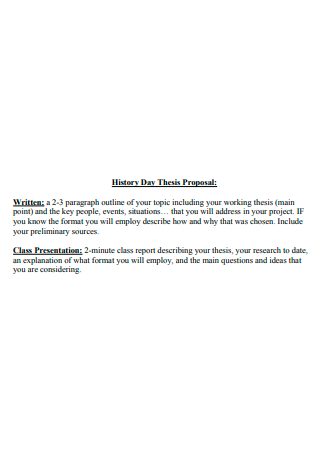
History Day Thesis Proposal
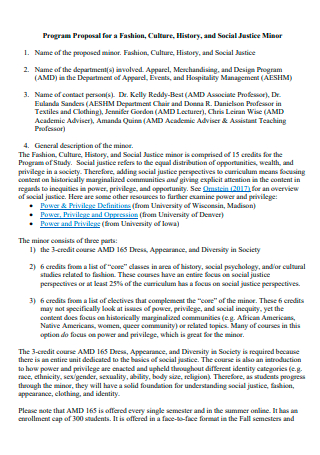
History Program Proposal
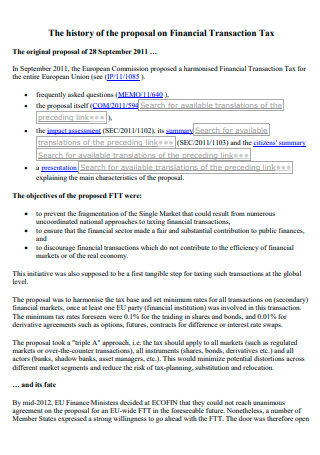
Financial Transaction Tax History Proposal
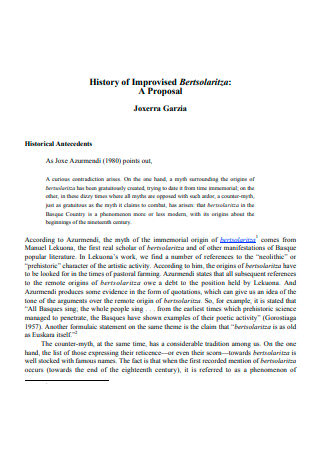
History Proposal in PDF
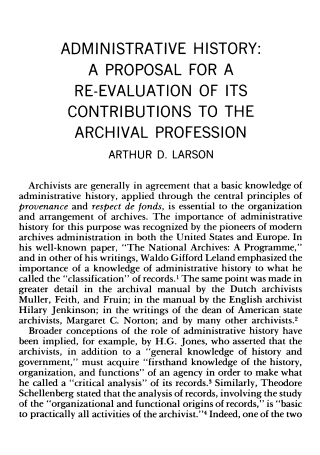
Administrative History Proposal
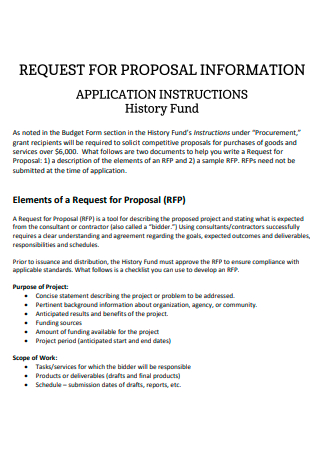
History Fund Proposal
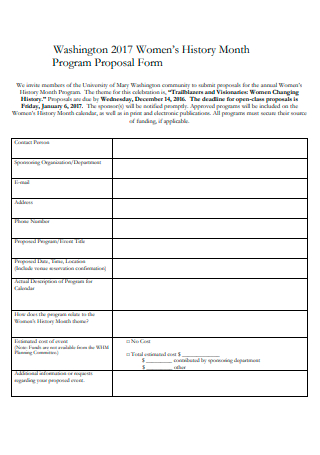
History Month Program Proposal Form

History Press Publication Proposal
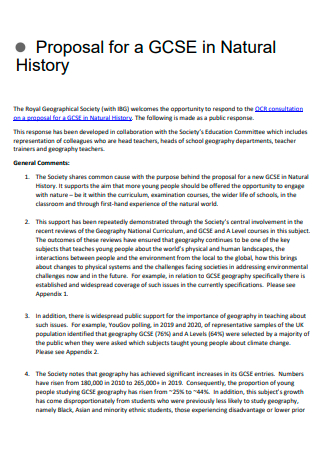
Natural History Proposal
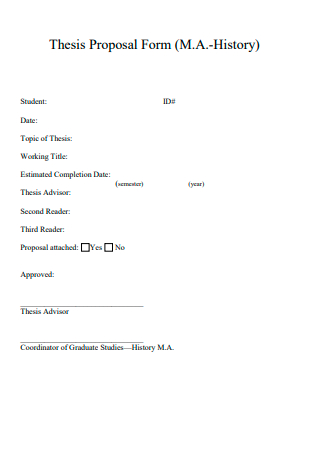
History Thesis Proposal Form
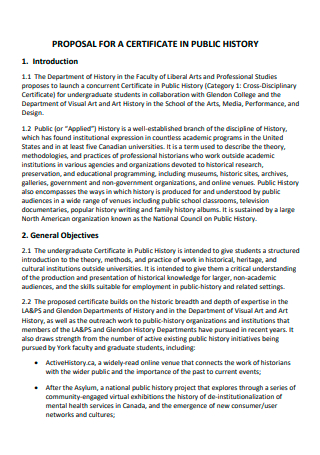
Public History Proposal For a Certificate
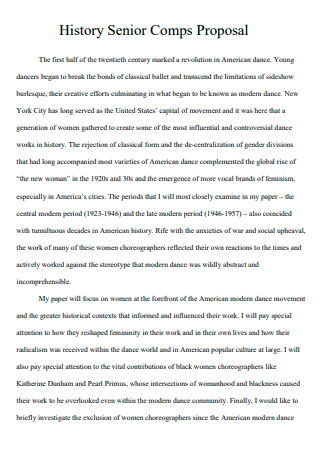
History Senior Proposal
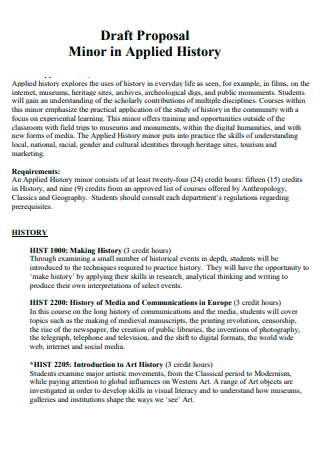
Minor in History Proposal

Basic History Proposal
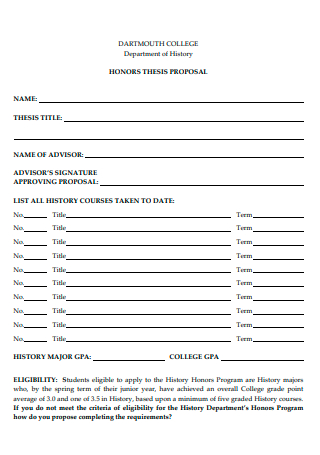
History Honors Thesis Proposal
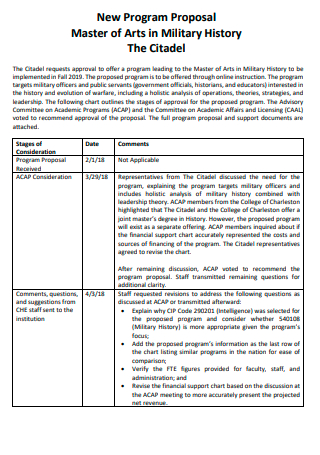
Master of Arts in Military History Program Proposal
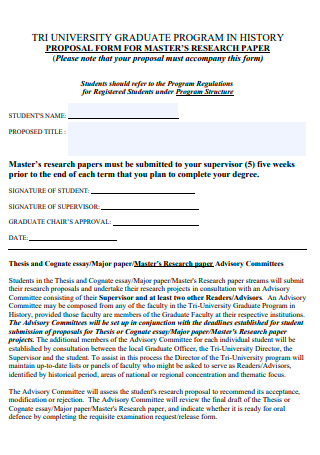
Graduate Program History Proposal Form For Master Research
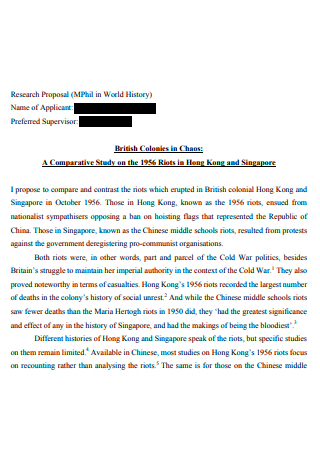
World History Research Proposal
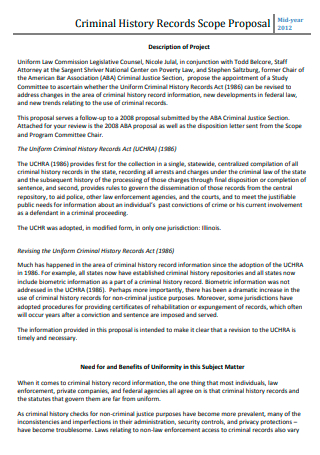
Criminal History Records Scope Proposal

Family Water Alliance History Project Proposal
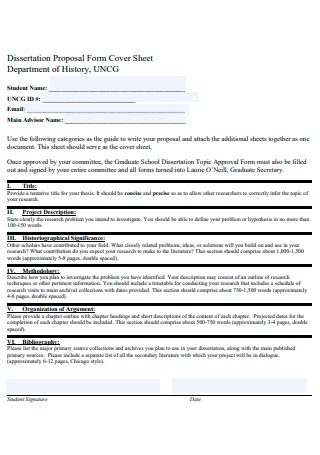
History Disseration Proposal Form
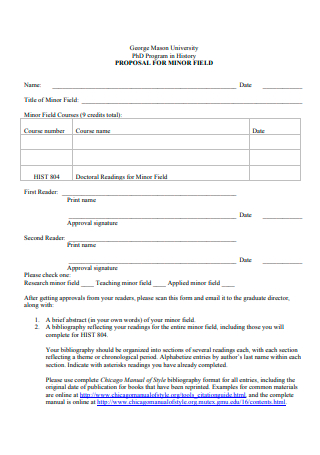
Program in History Proposal For Minor Field
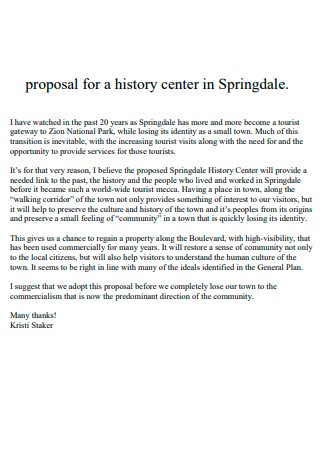
History Center Proposal
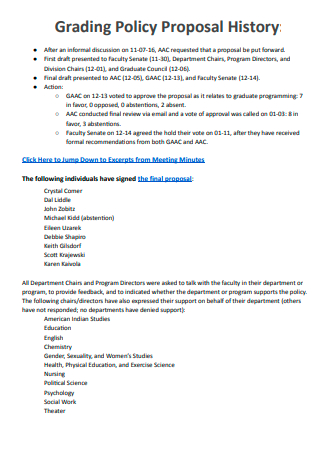
History Proposal Grading Policy
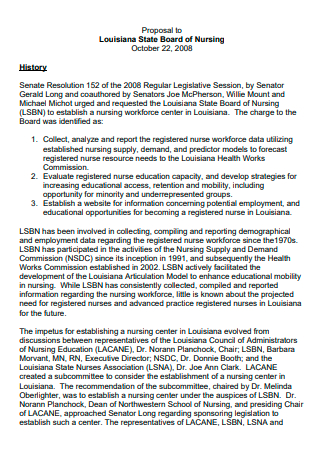
Board of Nursing History Proposal
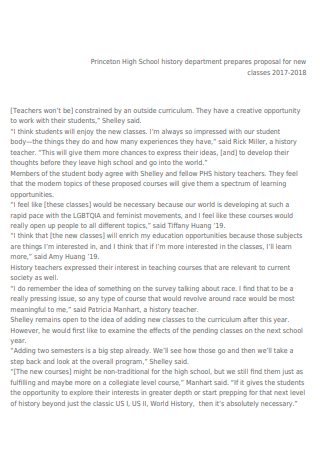
High School History Proposal

History and Visual Culture Dissertation Proposal
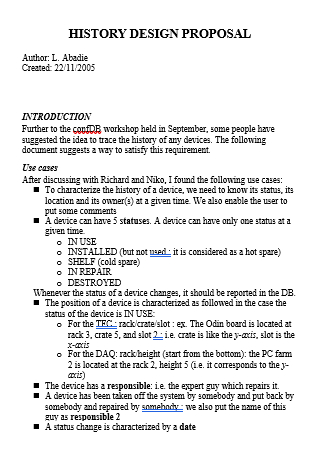
History Design Proposal
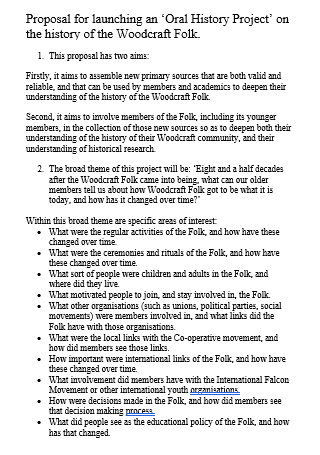
Oral History Proposal
Step 1: introduction, step 2: research problem , step 3: review of related literature , step 4: research design and methods, share this post on your network, file formats, word templates, google docs templates, excel templates, powerpoint templates, google sheets templates, google slides templates, pdf templates, publisher templates, psd templates, indesign templates, illustrator templates, pages templates, keynote templates, numbers templates, outlook templates, you may also like these articles, 25+ sample construction company proposal in ms word.

Navigating the intricate world of construction demands a seasoned company with a proven track record. Our comprehensive guide on the Construction Company Proposal is your blueprint to understanding the…
8+ SAMPLE Drama Proposal in PDF
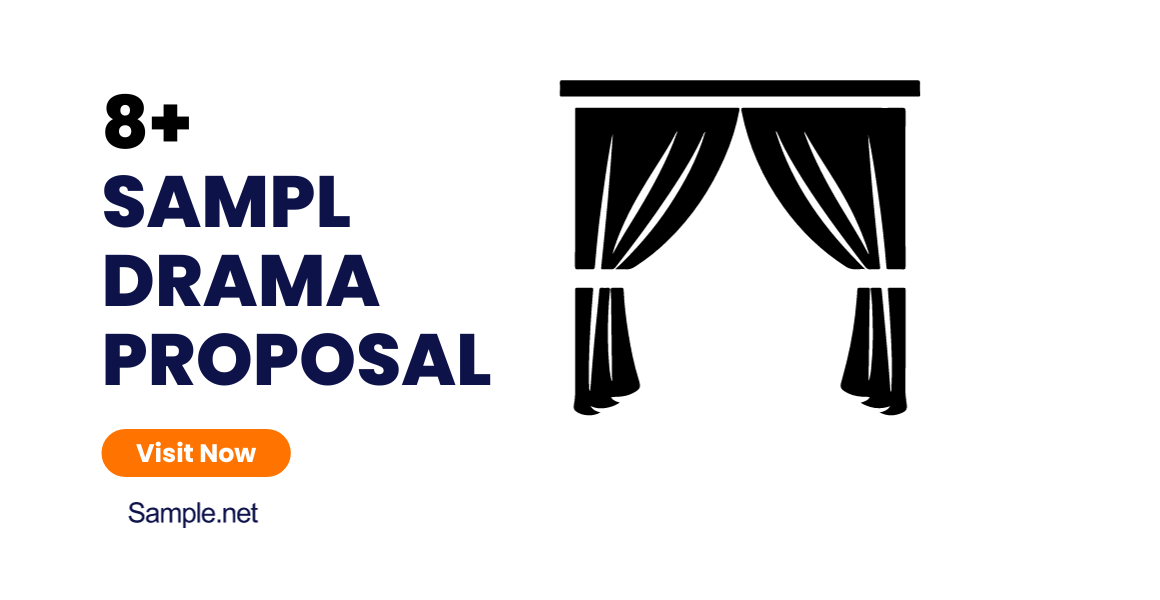
Julia Child said: “Drama is very important in life: You have to come on with a bang. You never want to go out with a whimper. Everything can have…
browse by categories
- Questionnaire
- Description
- Reconciliation
- Certificate
- Spreadsheet
Information
- privacy policy
- Terms & Conditions
- अन्वेषण करें हमारे बारे में समुदाय विविध लेख श्रेणियाँ
- श्रेणियाँ (categories) खोजें
- विकिहाउ के बारे में
- लॉग इन/ खाता बनाएं
- शिक्षा और संचार
कैसे प्रस्ताव (proposal) लिखें
यह आर्टिकल लिखा गया सहयोगी लेखक द्वारा Dave Labowitz . डेव लेबोविट्ज़ एक बिजनेस कोच है जो पूर्व-उद्यमियों, एकल उद्यमियों/उद्यमियों की मदद करते हैं और टीम के नेताओं को अपने व्यवसायों और टीमों को शुरू करने, स्केल करने और नेतृत्व करने में मदद करते हैं। अपने कोचिंग करियर की शुरुआत करने से पहले, डेव एक स्टार्टअप एक्जीक्यूटिव थे, जिन्होंने एक दशक से अधिक समय तक उच्च-विकास वाली कंपनियों का निर्माण किया। डेव के “पाथ लेस ट्रेवल्ड” जीवन में हाई स्कूल से ड्रॉप आउट करने, स्मिथसोनियन इंस्टीट्यूट में एक बुक का सह-लेखन, और पेपरडाइन के ग्राज़ियाडियो बिजनेस स्कूल में एमबीए प्राप्त करने जैसे रोमांच शामिल हैं। यहाँ पर 10 रेफरेन्स दिए गए हैं जिन्हे आप आर्टिकल में नीचे देख सकते हैं। यह आर्टिकल ५५,८९१ बार देखा गया है।
एक अच्छा प्रस्ताव या प्रपोजल (proposal) लिखना कई लिहाज से जरूरी होता है, व्यवसाय, स्कूल और बिजनस मैनेजमेंट से लेकर जियॉलॉजी (geology) सभी के लिए यह काफी महत्वपूर्ण योग्यता मानी जाती है। उपयुक्त लोगों को सूचना देकर उनका समर्थन प्राप्त करना एक अच्छे प्रपोजल का लक्ष्य है। अगर आप अपने विचारों और सुझावों को स्पष्ट रूप से, संक्षिप्त में, और आकर्षक रूप से पेश करेंगे, तो संभवतः लोग इनका समर्थन करेंगे। एक प्रभावी और आकर्षक प्रपोजल लिखने की जानकारी कई कार्यक्षेत्र में सफलता प्राप्ति के लिए आवश्यक है। प्रपोजल अनेक प्रकार के होते हैं, जैसे साइंस प्रपोजल और बुक प्रपोजल (book proposals), लेकिन बेसिक गाइडलाइन सभी प्रपोजल्स के लिए एक ही है।
अपने प्रपोजल की योजना बनाना

- आपका प्रपोजल कौन पढ़ेंगा? उनको आपके विषय के बारे में कितनी जानकारी हो सकती है? अपने विषय के बारे में आप क्या परिभाषा या अधिक जानकारी देना आवश्यक मानते हैं?
- अपने प्रपोजल से अपने ऑडीअन्स को आप क्या देना चाहेंगे? अपने ऑडीअन्स को आप क्या जानकारी देना चाहेंगे जिससे वह वही निर्णय लेंगे जो आप चाहते हैं?
- अपने शब्द स्पष्ट लिखें ताकि आप अपने ऑडीअन्स को उम्मीदों और कामनाओं से परिचय करवा सकें। वह क्या सुनना चाहेंगे? उन्हें विषय के बारे में परिचय देने का सबसे उचित तरीका क्या है? आप अपने विषय के बारे में ऑडीअन्स को कैसे समझा पायेंगे?

- आपका विषय किन परिस्थितियों में लागू हो सकता है?
- इस विषय को चुनने के पीछे क्या कारण हैं?
- क्या आप निश्चिंत हैं कि यही सही कारण है, बाकी नहीं? आप इसकी कैसे पुष्टि करेंगे?
- क्या इससे पहले किसी और व्यक्ति ने भी इस विषय के बारे में जानकारी हासिल करने कि कोशिश की है?
- अगर जवाब हाँ है: क्या वह सफल हुए हैं? क्यों?
- अगर जवाब नहीं है: क्यों सफल नहीं हुए हैं?

- अपने प्रपोजल में एक मसले की परिभाषा “और” उसका सुझाव देना आवश्यक है, जिससे रसहीन, संशयी ऑडीअन्स आपके प्रपोजल का समर्थन कर सकें। [५] X रिसर्च सोर्स अपने ऑडीअन्स के मन को जीतना इतना आसान नहीं होगा। क्या आपका सुझाव तार्किक और सहज है? अपने सुझाव को अमल करने का घटनाक्रम क्या है?
- अपने सुझाव को उद्देश्य की तरह लिहाज करने की कोशिश करें। आपका प्राथमिक उद्देश्य वह लक्ष्य है जिसे आपको अपने प्रॉजेक्ट में सिद्ध करना अनिवार्य है। माध्यमिक उद्देश्य वह लक्ष्य हैं जिसे आप सिद्ध करने की उम्मीद करते हैं।
- अपने सुझाव को “नतीजा” (outcomes) और “प्रदेय” (deliverables) के रूप में समझना एक और लाभदायक तरीका है। अपने उद्देश्य के नतीजे परिमाणित अंत हैं। उदाहरण के लिए, अगर आपका प्रपोजल किसी बिजनस प्रॉजेक्ट के लिए है और आपका उद्देश्य “मुनाफा बढ़ाना” है, तो आपका नतीजा “रु. 1,00,000 का मुनाफा कमाना” हो सकता है। प्रदेय ऐसे उत्पाद या सेवा हैं जिसे आप अपने प्रॉजेक्ट के साथ “प्रदान” करते हैं। उदाहरण के लिए, विज्ञान प्रॉजेक्ट के प्रपोजल में एक नई दवाई या टीका (vaccine) को “प्रदान” करने का विवरण हो सकता है। ऑडीअन्स प्रपोजल में नतीजे और प्रदेय की खोज करते हैं, क्योंकि किसी प्रॉजेक्ट का “मूल्य” तय करने के लिए यह सबसे आसान तरीकों में से एक माना जाता है। [६] X रिसर्च सोर्स

- शब्दावली (विशिष्ट तकनीकी बोली) अपनाने के बारे में ध्यान रखें। प्रभावशाली रचना शब्दावली (jargon) मुक्त होते हैं जब तक आप किसी विषय को शब्दावली के बिना वर्णन नहीं कर सकते। “श्रमिक संख्या की असंतुलन में सुधार” और “कर्मचारियों को जाने देना” के बीच में अंतर का विचार करें। द्वितीय तथ्य न सिर्फ स्पष्ट और प्रासंगिक है, यह कम शब्दों का इस्तेमाल करता है, ताकि अपने विचारों के बारे में आप ज़्यादा विवरण दे सकते हैं। [७] X रिसर्च सोर्स
- आप लोगों को कैसे यक़ीन दिला सकते हैं? प्रपोजल को विश्वसनीय बनाने के लिए भावुक गुहार का प्रयोग करें, पर इसके लिए अपने दलील को तथ्य के आधार पर निर्भर होना चाहिए। उदाहरण के लिए, बाघ संरक्षण के प्रपोजल में आप चर्चा कर सकते हैं कि कितना दुखद होगा जब आने वाली पीढ़ी के बच्चे कभी बाघ नहीं देख पाएंगे, पर यह “रुकना” नहीं चाहिए। इस दलील को विश्वसनीय बनाने के लिए तथ्य और सुझाव के आधार पर निर्भर होना चाहिए।

- अपने सारांश में आपका मसला, आपका सुझाव, कैसे इसका समाधान निकालेंगे, आपका सुझाव क्यों उचित है, और एक समाप्ति शामिल होनी चाहिए। अगर आप एक कार्यकारी (executive) प्रपोजल तैयार कर रहे हैं, तो आपको बज़ट विश्लेषण और व्यवस्थापन जानकारी को प्रपोजल में शामिल करना होगा।
अपने प्रपोजल को लिखना

- अगर आप किसी अटल सत्य से अपने विषय पर रोशनी डाल सकते हैं तो तुरंत इसे संबोधित करें, इससे शुरू करना आपके लिए सबसे कुशल विचार साबित होगा। जो भी है, निश्चित करें कि आप एक सत्य के साथ शुरू कर रहे हैं और यह आपका अभिप्राय नहीं है।

- अपने मसले का समाधान क्यों निकालने की ज़रूरत है और इसे क्यों अभी सुलझाने की ज़रूरत है, इस विषय पर जोर दें। अगर ऐसे ही छोड़ दिया तो आपके ऑडीअन्स पर क्या असर होगा? सुनिश्चित करें कि आप सारे प्रश्नों का उत्तर शोध और हकीकत के साथ पेश करें। विश्वसनीय स्तोत्र को उदारता से प्रयोग करें।
- अपने प्रपोजल को विशेषक से घेरा या उलझन करने या इधर-उधर की बातें करने की कोशिश न करें। इस अनुभाग के ज़रिये अपने ऑडीअन्स को विश्वास दिलाना चाहिए कि एक मसला है, और वह महत्वपूर्ण है। “मुझे भरोसा है कि मेरे प्रपोजल से ज़िले की गरीबी पर काफी असर पड़ेगा” लिखने से आपके ऑडीअन्स को किसी बात पर विश्वास नहीं होगा। सीधा और संक्षिप्त रहें। “इस प्रस्तावित योजना से ज़िले में गरीबी को हटाना उल्लेखनीय है,” ज़्यादा विश्वसनीय है।

- अपने विचारों के असर के बारे में चर्चा करें। जिन विचारों की उपयुक्तता सीमित हैं वह ऑडीअन्स में उत्सुकता नहीं भर सकते, जितनी उन विचारों की उपयुक्तता, उतना ही व्यापक उसका असर हो सकता है। उदाहरण के लिए: “टूना मछली के व्यवहार के बारे में बेहतर ज्ञान प्राप्त करने से हम एक ज़्यादा विस्तृत अनुशासन करने की योजना बना सकते हैं और भविष्य की पीढ़ी को टूना मछली कैन करना पक्का कर सकते हैं।”
- अपने प्रपोजल में आप क्या करना चाहेंगे उतना ही महत्वपूर्ण है जितना कि आप “क्यों” वह करना चाहेंगे। मान लेते हैं कि आपके ऑडीअन्स संशयी हैं और वह आपके विचारों से प्रत्यक्ष मूल्य पर सहमत नहीं हैं। अगर आप 2000 टूना मछली पकड़ कर-शोध करके-उन्हें छोड़ने का प्रपोजल पेश करते हैं, तो क्यों? क्या इससे बेहतर कोई विकल्प है? अगर यह महंगा विकल्प है, तो इससे सस्ता विकल्प को क्यों नहीं चुन सकते? पूर्वानुमान करके और ऐसे प्रश्नों का उत्तर तैयार करने से आपके ऑडीअन्स को पता चलेगा कि आपने अपने विचारों के हर पहलू पर गौर किया है।
- आपके प्रपोजल को पढ़ने के बाद आपके ऑडीअन्स को लगना चाहिए कि आप इस मसले का कुशलतापूर्वक हल निकाल सकते हैं। जो भी आप अपने प्रपोजल में पेश करते हैं, उसमें पूरी तरह से सिर्फ मसले या उसके समाधान के बारे में होना चाहिए।
- बड़े पैमाने पर प्रपोजल का शोध करें। जितने ज़्यादा उदाहरण और तथ्य आप अपने ऑडीअन्स को पेश करेंगे, उतना बेहतर होगा – यह ज़्यादा विश्वसनीय होगा। अपने अभिप्राय का त्याग करें और दूसरों के ठोस शोध पर भरोसा करें।
- अगर आपके प्रपोजल में पेश किए गए सुझाव सफल साबित नहीं हो सकता है, तो वह सुझाव उचित नहीं है। अगर आपका सुझाव सहज नहीं है, तो उसे बाहर निकाल दें। अपने सुझाव के परिणाम के बारे में भी ध्यान रखें। अगर हो सके तो अपने सुझाव का पूर्व-निरीक्षण करें और उसे बदलने की कोशिश करें।

- आप अपना प्रॉजेक्ट कब शुरू करने की कल्पना कर रहे हैं? आपके प्रॉजेक्ट की प्रगति का रफ्तार क्या होगा? हर कदम पिछले कदम पर कैसे आधारित होगा? क्या कुछ चीजों को एक-साथ कर सकते हैं? जितना हो सके कुशल बने ताकि अपने ऑडीअन्स को विश्वास दिला सकें कि आप आवश्यक कार्य करके आये हैं और उनका निवेश व्यर्थ नहीं जाएगा।
- सुनिश्चित कर लें कि आपका प्रपोजल आर्थिक रूप से सुदृढ़ है। अगर आप अपने प्रपोजल को किसी कंपनी या व्यक्ति को पेश कर रहे हैं, तो उनके बज़ट पर ध्यान रखें। अगर वह आपके प्रपोजल का खतरा नहीं उठा सकते, तो आपका प्रपोजल समुचित नहीं है। अगर प्रपोजल उनके बज़ट से तालमेल रखता है, तो उनके समय और पैसे का मूल्य शामिल करना न भूलें।

- अगर आपके प्रपोजल में कुछ अतिरिक्त तथ्य हैं जो सही मायने में अनुरूप नहीं हैं, तो आप एक अतिरिक्त अनुभाग (appendix) को जोड़ें। परंतु आप यह भी जानते हैं कि जितना मोटा आपका प्रपोजल होगा, लोग इसे देखकर डर जाएंगे। अगर आपको संदेह है, तो इस भाग को शामिल न करें।
- अगर आपके प्रपोजल में दो से ज़्यादा अनुभाग है, तो उन्हें क, ख, आदि से नामांकन करें। यह आप तब इस्तेमाल कर सकते हैं जब आपके पास आंकड़ा पत्रक (data sheet), पुनः प्रकाशित उल्लेख (reprint of articles), या समर्थन पत्र (letters of endorsement) जैसे दस्तावेज़ हैं। [१३] X रिसर्च सोर्स

- एक (या दो) लोगों को अपने प्रपोजल पर नज़र डालने को कहें। वह प्रपोजल में समस्याओं को चिन्हांकित कर सकते हैं जिसे आपने नजरंदाज किया होगा। ऐसी समस्याएं होंगे जिन्हें आप पूरी तरह से संबोधित करना भूल गए होंगे या ऐसे प्रश्न जिन्हें आपने खुला छोड़ दिया है।
- शब्दावली (jargon) और पिष्टोक्ति (clichés) का प्रयोग न करें! इससे ऑडीअन्स को लगेगा कि आप आलसी है और उनके समझने में बाधा डाल सकते हैं। जहाँ छोटे शब्द का इस्तेमाल कर सकते हैं वहां लंबे शब्द का इस्तेमाल न करें। [१६] X रिसर्च सोर्स
- जहाँ तक हो सके कर्मवाच्य (passive voice) का प्रयोग करना टालें। कर्मवाच्य में “करना होगा” जैसे क्रियावाचक शब्द का प्रयोग होता है और आपके अर्थ अस्पष्ट हो जाएंगे। इन दो वाक्यों की तुलना करें: “खिड़की नीरस व्यक्ति (zombie) द्वारा तोड़ी गई है” और “नीरस व्यक्ति (zombie) ने खिड़की तोड़ी।” पहले वाक्य में आपको पता नहीं है कि “किसने” खिड़की तोड़ी: नीरस व्यक्ति ने तोड़ी? या फिर नीरस व्यक्ति खिड़की के पास खड़ा था जो टूटी हुई थी? दूसरे वाक्य में, वास्तव में आपको पता है कि कौन तोड़ रहा है और यह महत्वपूर्ण क्यों है।

- आपकी ओर से कोई भी गलती आपको कम शिष्ट और विश्वसनीय दिखाई देगी, जिससे ऑडीअन्स आपके प्रपोजल को समर्थन देने के आसार कम हो जाते हैं।
- निश्चित करें कि प्रपोजल लिखने के गाइडलाइन के अनुसार आपने फॉर्मेट किया है।
- ऐसे शब्द का प्रयोग करें जो ऑडीअन्स आसानी से समझ सकें। छोटे वाक्य का प्रयोग करें जो स्पष्ट और प्रासंगिक है।
- किसी भी आर्थिक या अन्य साधन के बारे में चर्चा सावधानी से करनी चाहिए और होने वाले अपेक्षित खर्च की वास्तविक तस्वीर दिखाएं।
संबंधित लेखों

- ↑ http://orsp.umich.edu/proposal-writers-guide-overview
- ↑ https://owl.english.purdue.edu/media/pdf/20080628094326_727.pdf
- ↑ http://facstaff.gpc.edu/~ebrown/pracguid.htm
- ↑ http://www.nsf.gov/pubs/2004/nsf04016/nsf04016.pdf
- ↑ ५.० ५.१ http://www.dailywritingtips.com/how-to-write-a-proposal/
- ↑ http://www.plainlanguage.gov/howto/wordsuggestions/jargonfree.cfm
- ↑ १३.० १३.१ http://orsp.umich.edu/proposals/pwg/pwgcomplete.html
- ↑ http://www.forbes.com/sites/augustturak/2013/02/18/how-to-write-a-plan-or-proposal-that-rocks/
- ↑ http://c.ymcdn.com/sites/www.apmp.org/resource/resmgr/podcasts/clear_prop_writing.pdf
विकीहाउ के बारे में

- प्रिंट करें
यह लेख ने कैसे आपकी मदद की?
सम्बंधित लेख.

- हमें कॉन्टैक्ट करें
- यूज़ करने की शर्तें (अंग्रेजी में)
- Do Not Sell or Share My Info
- Not Selling Info
हमें फॉलो करें

क्रियात्मक शोध के चरण
Contents in the Article
क्रियात्मक शोध के चरण

प्रथम सोपान- समस्या चयन ( Selection of the Problem)
किसी भी अनुसन्धान का सबसे पहला सोपान वह समस्या होती है जिसके सम्बन्ध में अनुसन्धान किया जाना है; क्योंकि समस्या के अभाव में समाधान किसका किया जाए? समस्या के समाधान के लिए आवश्यकता है-अनुसन्धान की। अत: अनुसन्धानकर्ता को सबसे पहले उस समस्या को समझना चाहिए, जिसे वह हल करना चाहता है; क्योंकि समाधान हेतु की गई समस्त क्रियाएँ भी समस्या से सम्बन्धित ही होंगी। जब शिक्षक या अनुसन्धानकर्ता को अपनी समस्या का ही पता नहीं होगा तो उसके द्वारा किए गए समस्त प्रयास निरर्थक ही होंगे; परन्तु उन्होंने जो भी प्रयत्नों की रूपरेखा बनाई, उसमें मौखिक अभिव्यक्ति के अतिरिक्त लिखित अभिव्यक्ति को कहीं स्थान ही नहीं था। इसका आशय स्पष्ट था कि उनकी दृष्टि में उच्चारण एवं वर्तनी दोनों एक ही हैं। यथार्थतः, दोनों एक न होकर अलग-अलग हैं। यद्यपि दोनों परस्पर सम्बद्ध अवश्य हैं; परन्तु एक नहीं। उच्चारण का सम्बन्ध मौखिक अभिव्यक्ति से है तो वर्तनी का सम्बन्ध लिखित अभिव्यक्ति से। अतः किसी समस्या का समाधान खोजने से पूर्व उस समस्या को भली-भाँति समझा जाना चाहिए।
द्वितीय सोपान – समस्या को परिभाषित करना (Defining the Problem)
इसके अन्तर्गत-आप जिस समस्या पर कार्य कर रहे हैं, उसको स्पष्ट कीजिए कि वास्तव में उस समस्या से आपका तात्पर्य क्या है; उदाहरण के लिए-वर्तनी वाली समस्या को ही बताइए कि अधिकतर लड़के लिखने में अशुद्धियाँ करते हैं। वे ‘बीड़ी’ का ‘बिड़ी’, ‘फूल’ का ‘फुल’ लिखते हैं।
तृतीय सोपान – समस्या सीमांकन (Delimiting the Problem)
इसके अन्तर्गत-समस्या के उस क्षेत्र को बताइए जहाँ आप कार्य करेंगे; उदाहरणार्थ-वर्तनी सम्बन्धी अशुद्धियाँ तो प्रत्येक पाठशाला के छात्र कर सकते हैं; परन्तु आप सभी पाठशालाओं के सभी छात्रों की अशुद्धियों का संशोधन कर सकें-यह कम ही सम्भव है। अत: आपको अपनी समस्या के समाधान हेतु अपनी पाठशाला को चुनना पड़ेगा। अपनी पाठशाला में भी यदि बहुत-सी कक्षाएँ हैं तो यह सम्भव नहीं कि आप सभी कक्षाओं में सभी छात्रों की वर्तनी सम्बन्धी अशुद्धियों को दूर कर सकें। ऐसी स्थिति में आपको अपनी कक्षा या कुछ सीमित कक्षाएँ ही लेनी पड़ेंगी और इस सोपान के अन्तर्गत उस पाठशाला एवं कक्षा का उल्लेख करना होगा, जिसमें आप अपना अनुसन्धान कार्य करेंगे!
चतुर्थ सोपान – समस्या के सम्भावित कारणों का पता लगाना तथा कारणों का विश्लेषण
इस सोपान के अन्तर्गत उन कारणों पर विचार कीजिए जो वर्तनी सम्बन्धी अशुद्धियों मूल कारण हैं; उदाहरण के लिए निम्न कारण हो सकते हैं-
- बालकों का अशुद्ध उच्चारण,
- उच्चारण पर स्थानीय प्रभाव,
- वर्तनी सम्बन्धी के नियमों से अनभिज्ञ होना,
- शिक्षकों का अपूर्ण ज्ञान आदि।
अब पुनः इन कारणों पर विचार कीजिए और देखिए कि इन सभी कारणों में सबसे प्रमुख कारण कौन-सा है ?
पंचम सोपान – क्रियात्मक परिकल्पना-निर्माण (Formulation of Action Hypothesis)
इसके अन्तर्गत-आप उन क्रियाओं पर विचार कीजिए, जिनके द्वारा समस्या के ऊपर दिए हुए कारणों को मिटाया या दूर किया जा सके; उदाहरण के लिए-हम छात्रों की वर्तनी सम्बन्धी अशुद्धियों को दूर करने के लिए कई क्रियायें अपना सकते हैं। क्रियायें हो सकती हैं-
- पहले शिक्षकों द्वारा की जाने वाली वर्तनी सम्बन्धी अशुद्धियों को दूर करने के लिए उपलब्ध साधन-सुविधाओं के अनुसार शिक्षक संगोष्ठियों का आयोजन करें। एक ही पाठशाला के सभी शिक्षक एक साथ बैठकर इस पर विचार कर सकते हैं।
- पुनः, विद्यार्थियों की सामान्य अशुद्धियाँ, अर्थात् उन अशुद्धियों को दूर करने के लिए जो प्रायः अधिकतर विद्यार्थियों द्वारा की जाती हैं; सामूहिक कार्यक्रम चलायें। इस कार्यक्रम में उन्हें वर्तनी सम्बन्धी नियमों से अवगत करायें।
- विद्यार्थियों द्वारा व्यक्तिगत रूप से की जाने वाली वर्तनी सम्बन्धी अशुद्धियों को अलग से; अर्थात् व्यक्तिगत रूप से ही विद्यार्थियों को बतायें।
षष्ठ सोपान – अभिकल्प निर्माण एवं उपकरणों का विकास (Developing Design and Tools for Action Hypothesis)
इस सोपान के अन्तर्गत-आप उन सभी बातों पर विचार कीजिए, जिनके द्वारा आप अपने प्रयत्नों का मूल्यांकन कर सकें। मूल्यांकन हेतु जो भी उदाहरण तैयार करने हों, उनका निर्माण-उल्लेख भी इसी सोपान के अन्तर्गत कीजिए; उदाहरण के लिए-ऊपर की समस्या के लिए ही वर्तनी सुधार के लिए किए गए प्रत्येक प्रयत्न के पश्चात् उसके परिणामों का परीक्षण किया जा सकता है और उसके लिए उन शब्दों की सूची तैयार की जा सकती है, जिन्हें लिखने में बालक प्रायः भूल करते हैं। इसी सूची के शब्दों को समयान्तर से लेखनी की दृष्टि से समान शब्दों द्वारा बदला जा सकता है।
सप्तम सोपान – विश्लेषण (Analysis)
इस सोपान के अन्तर्गत समस्या के समाधान हेतु आपके द्वारा किए गए प्रयासों या प्राप्त आंकड़ों का विश्लेषण कीजिए। इसमें सांख्यिकीय गणना के आधार पर आप यह ज्ञात कर सकते हैं कि आपके द्वारा छात्रों की वर्तनी सम्बन्धी अशुद्धियों के सुधार में क्या और कितना परिवर्तन आया ?
अष्टम सोपान – निष्कर्ष (Conclusion)
इसके अन्तर्गत आप अपने द्वारा वर्तनी सुधार के प्रयलों में जिस निष्कर्ष पर पहुँचे, उसका उल्लेख कीजिए और बताइए कि विद्यार्थियों में क्या परिवर्तन आया और यदि आपके प्रयत्नों में कोई कमी रह गई तो है उसे आगे कैसे दूर किया जा सकता है ?
उपकरण निर्माण- अनुसंधान समस्या से सम्बन्धित परिकल्पना की रचना के पश्चात् उसके परीक्षण के लिए आवश्यक तथा तर्कसंगत आँकड़ों के संकलन की आवश्यकता होती है। इसके लिए प्रयुक्त साधन को उपकरण कहते हैं। क्रियात्मक अनुसंधान में समस्या न्यादर्श व जनसंख्या को ध्यान में रखकर उपयोगितानुसार उपकरणों का निर्माण किया जाता है। क्रियात्मक अनुसंधान में उपकरण इस प्रकार हो सकते हैं- प्रश्नावली, सर्वेक्षण, अवलोकन, साक्षात्कार, अनुसूची, अनुश्रवण, पर्यवेक्षण, अनुभवों का संयोजन तथा निरीक्षण के स्वरूप में होते हैं।
उपकरण के निर्माण में ध्यान रखना चाहिए कि उपकरण में उत्तरदाता को ज्यादा लिखना न पड़े तथा उसके मन में स्वाभाविक बात निकल आए और उपकरणों से प्राप्त होने वाले तथ्य विश्वसनीय, वैध व वस्तुनिष्ठ हों। उपकरण लिखित, मौखिक, भौतिक-सूक्ष्म परिकल्पना की आवश्यकता व न्यादर्श की पूर्ण क्षमता अनुसार होना चाहिए।
महत्वपूर्ण लिंक
- निर्देशन के उद्देश्य (Aims of Guidance in Hindi)
- क्रियात्मक अनुसन्धान (Action Research)- अर्थ, क्षेत्र (Scope), महत्व, लाभ
- क्रियात्मक शोध के चरण या सोपान (Steps of Action Research)
- शैक्षिक निर्देशन (Educational Guidance)-परिभाषा, विशेषताएँ, सिद्धान्त
- शैक्षिक निर्देशन-उद्देश्य एवं आवश्यकता (Objectives & Need)
- व्यावसायिक निर्देशन (Vocational guidance)- अर्थ, उद्देश्य, शिक्षा का व्यावसायीकरण
- परामर्श (Counselling)- परिभाषा, प्रकार, उद्देश्य, विशेषताएँ
- व्यावसायिक निर्देशन- आवश्यकता एवं उद्देश्य (Need & Objectives)
- अनुसंधान (Research)- अर्थ, परिभाषा, उद्देश्य और वर्गीकरण
- विशेष शिक्षा की आवश्यकता | Need for Special Education
- New Education Policy 1986- Characteristics & Objectives in Hindi
- राष्ट्रीय शिक्षा नीति-1992 की संकल्पनाएँ या विशेषताएँ- NPE 1992
Disclaimer: wandofknowledge.com केवल शिक्षा और ज्ञान के उद्देश्य से बनाया गया है। किसी भी प्रश्न के लिए, अस्वीकरण से अनुरोध है कि कृपया हमसे संपर्क करें। हम आपको विश्वास दिलाते हैं कि हम अपनी तरफ से पूरी कोशिश करेंगे। हम नकल को प्रोत्साहन नहीं देते हैं। अगर किसी भी तरह से यह कानून का उल्लंघन करता है या कोई समस्या है, तो कृपया हमें [email protected] पर मेल करें।
About the author
Wand of Knowledge Team
Leave a comment x.
Save my name, email, and website in this browser for the next time I comment.

- About NuWrite
- Writing Advice
- Engineering & Design
- First-Year Seminars
- Global Health
- 2010 Senior Thesis Prep Guide (B. Zakarin 2010)
- Local Library Collections (for Humanities research) (B. Zakarin 2010)
- solving-problems-in-history-proposal-research
- writing-history-proposals
- Science Writing
- Social Science Writing
- Writing for Graduate or Professional School
- Writing Advice for International Students
- Faculty-Only Resources
Effective Proposal-Writing Style (for History students)
Contributed by B. Zakarin, Office of Fellowships, [email protected] Posted: 2010 Originally written for History students writing proposals for a senior honors thesis, but applicable to all proposal writing
printable file (Word)
Personal pronouns
Writers use first person (“I,” “my”) when discussing their own interests and plans. This is appropriate in a research proposal because you will be admitted to the Senior Thesis Program and/or awarded a summer grant.
Well-organized paragraphs and headings
For the most part, writers use topic sentences to signal a paragraph’s key point. That point often corresponds to a required element, such as “what I want to learn,” “what scholars have previously studied,” or “where I plan to find sources.” Writers then add details that explain the topic sentence or argue the point it makes. Also, paragraphs should not be overly long.
In addition to well-organized paragraphs, writers sometimes use headings to identify key sections. Such organization is helpful because readers often skim the beginnings of sections and paragraphs to find a proposal’s main argument before they go back for details. Headings and topic sentences highlight a proposal’s structure.
Action-Oriented sentences
A preponderance of sentences should use active voice. In other words, sentences emphasize who (or what) performs the action:
- My project will use…
- The current literature does not show…
- I contend…
- I have prepared for this work by…
- To answer these questions, I will analyze…
- This project will allow me to…
- This study focuses on…
- Bibliographies mention…
- I need to visit…
Active voice makes sentences shorter and clearer and makes writers sound confident. Use passive voice when you have a legitimate reason for doing so, such as when the actor is not important or when passive voice promotes coherence. Consider these examples from the model proposals:
- “Several Connecticut newspapers circulated in Windham were known for their extreme zealotry.” It is not necessary for Alex Jarrell to say that the public knew these newspapers for their zealotry.
- “In the 18 th century, prostitutes were increasingly considered to be outside the sphere of womanhood. In the late 1760s, 2069 women were arrested.” Who “considered” or “arrested” the women is obvious and unimportant for Arianne Urus’s purposes.
- “Elisabeth Julie Lacroix, for example, was a 49-year-old woman arrested in 1778, who had been abandoned by her husband, out of work four to five days, and without food for one day. Her story is replicated countless times…” Arianne’s use of the passive voice allows her to keep the focus on Elisabeth’s story.
Active or passive voice is only an issue with action (transitive) verbs, which have objects. Some sentences simply use state-of-being (intransitive) verbs, such as “is” or “was”:
- “The New London Gazette is available at the Northwestern Library on microfilm.” ( Alex )
- “Martin Luther King’s status in the community was under fire.” ( Casey Kuklick )
These intransitive verbs are often necessary, but in a well-written proposal, active verbs in the active voice will dominate.
Conciseness
Good proposal writers explain their ideas as succinctly as possible. Most writers start with a proposal that is a little too long. Then they solicit help from advisors and peer reviewers to trim the fat. Along with unnecessary background information, you should be vigilant about clunky phrases and excessive qualifying words. The following strategies for revision will help.
- Change passive to active voice (see above)
- Wordy: “It is these three facts that call Jones’s theory into question.” Concise: “These three facts call Jones’s theory into question.”
- Wordy: “There were numerous laws in the 1890s that led to the arrests.” Concise: “Numerous laws in the 1890s led to the arrests.”
- Wordy: “It is my contention in this proposal that…” Concise: “In this proposal, I contend that…”
- Wordy: “It is the belief of most scholars that…” Concise: “Most scholars believe that…”
- Wordy: “This project focuses on the analysis of…” Concise: “This project will analyze…”
- Wordy: “Identification and evaluation of the first problem are necessary for resolution of the second.” Concise: “We must identify and evaluate the first problem before we can resolve the second.”
- Wordy: “Most critics are in agreement with this assessment.” Concise: “Most critics agree with this assessment.”
- Wordy: “at this point in time” Concise: “now”
- Wordy: “due to the fact that” Concise: “because”
- Wordy: “at a later time” Concise: “later” or “next” or “then”
- Wordy: “for the purpose of” (as in “for the purpose of determining”) Concise: “for” or “to” (as in “for determining” or “to determine”)
- Wordy: “a majority of” Concise: “most”
Effective use of transitions
Transitional words and phrases show how sentences and ideas are related to each other. Used correctly, they make it easier for readers to follow your argument. The following transitions at or near the beginnings of sentences will make your logic come through clearly and coherently to readers.
- To show results —“therefore,” “as a result,” “consequently,” “thus,” “hence.”
- To show addition —“moreover,” “furthermore,” “also,” “too,” “besides,” “in addition.”
- To show similarity —“likewise,” “also,” “similarly.”
- To show contrast —“however,” “but,” “yet,” “still,” “conversely,” “nevertheless,” “on the other hand” (if you have used “on the one hand” previously).
- To show examples —“for example,” “for instance,” “specifically,” “as an illustration.”
- To show sequence or tim e—“first,” “second,” “third”; “previously,” “now,” “finally,” “later”; “next,” “then.”
- To show spatial relations —“on the east,” “on the west”; “left,” “right”; “close up,” “far away.”
Repetition and parallelism
As the model proposals show, it is often effective to repeat key terms and phrases: “I will pursue research in three areas…; I will travel to X in July in order to…; I will then go to Y so that I can…“ The repetition in these sentences helps readers focus on the student’s proposed actions.

- Contact Northwestern University
- Campus Emergency Information
- University Policies
Northwestern University Library | 1970 Campus Drive, Evanston, IL 60208-2300 | Phone: 847.491.7658 | Fax: 847.491.8306 | Email: [email protected]

IMAGES
VIDEO
COMMENTS
F. N. Kerlinger. Research Methods in Education: An Introduction. Article. Nov 1971. William J. Bramble. John W. Best. Armand J. Galfo. William Wiersma. PDF | On Dec 26, 2016, Patanjali Mishra ...
कैसे एक शोधपत्र (Research Paper) लिखें. स्कूल की ऊंची कक्षाओं में पढ़ने के दौरान और कॉलेज पीरियड में हमेशा ही, आपको शोध-पत्र तैयार करने के लिए कहा जाएगा। एक शोध ...
ऐतिहासिक अनुसंधान पद्धति : इतिहास शब्द का उद्गम 'Historia' शब्द से हुआ है, जिनका मूल अर्थ होता है सीखना या खोज द्वारा प्राप्त किया गया ज्ञान। प्राचीनकाल में ...
In this video we will understand How to write a research Proposal ? How to write Perfect Research Proposal, How to write research proposal for PhD, how to wr...
History has been defined differently by different scholars. Following definitions indicate the meaning of History. Aristotle: "History contrasts research into the facts, with the logical task of explanation." The term 'contrasts' is very significant here, as it suggests that things in history are related to one another in a systematic
The research proposal you submit in January should be approximately 1000 words, plus a bibliography, and should contain the following: A title, possibly with a subtitle. The title should not take the form of a question and it may run to a dozen words or more. Like the title of a book, it should clearly convey the topic you propose to work on.
5 thoughts on "[100+Pdf] Research Topics Of History In Hindi-इतिहास के शोध विषय" Pingback: Home - Research Scholar Pingback: Home Page 3 - Research Scholar
How to write a Research Proposal | Research Proposal | Basic Science Series Hindi Title of a Research ProposalIntroduction of a Research ProposalSignificance...
pravashi hindi sahityo me vyakt bhartiya evam pashchyat sanskruti ka sangharsh: sarvaiya mayur parshotambhai: ravjibhai m rathod: 8-Aug-2023: gujarati ek malvi lokgeet loknatya lok sahitya ke drashyo shravygt anushilan: pargi nayna v: Gamit, N.T. 8-Aug-2023: hindi ki peamukh mahila kahanikaro ke kahani sahitya me nirupit samajik samashya
The word "Shodh" originates from Sanskrit and stands for "research and discovery". "Gangotri" is one of the largest glaciers in the Himalayas and the source of origination of the Ganges, the holiest, longest, and largest of rivers in India. The Ganges is the symbol of age-long culture, civilization, ever-aging, ever-flowing, ever ...
A research proposal, also known as a research prospectus, describes a project's intended course and its intellectual merit. In the process, you are expected to explain its historiographical context and how you intend to complete it. A well-written proposal should demonstrate that your project is unique and necessary. The Parts of a Research ...
Research Methods in Indian History Page 5 CHAPTER-I IDENTIFICATION OF A HISTORICAL PROBLEM DEFINITION, NATURE AND SCOPE 1. The Term 'Research Methodology' is a compound of two words, research and methodology, indicating the mode of doing research. 'Research' is of French origin (from Recerche) and means a "careful search or investigation,
Step 2: Research Problem. The next step is to state your research problem statement and provide some background on it. The objective of a history proposal, after all, is to explore and gain insight to your historical topic. The significance of the study and its relation to society can be further examined in this section.
कैसे प्रस्ताव (proposal) लिखें. एक अच्छा प्रस्ताव या प्रपोजल (proposal) लिखना कई लिहाज से जरूरी होता है, व्यवसाय, स्कूल और बिजनस मैनेजमेंट से लेकर जियॉलॉजी (geology) सभी ...
प!रमाणा मक एवं ग ुणा म क शोध (Types of Educational Research: Fundamental, Applied, and Action Research, Quantitative and Qualitative Research) 03 शैिक अन ुसंधान क% िविधयाँ : ˚योगा म क शोध , ऐितहािसक शोध , के स
निर्देशन के उद्देश्य (Aims of Guidance in Hindi) क्रियात्मक अनुसन्धान (Action Research)- अर्थ, क्षेत्र (Scope), महत्व, लाभ; क्रियात्मक शोध के चरण या सोपान (Steps of Action Research)
The paper is an attempt to reconstruct some events of the past quite close to Independence through the writings of sensitive authors of that era. Role of a national leader of the stature revered ...
The Shodhganga@INFLIBNET Centre provides a platform for research students to deposit their Ph.D. theses and make it available to the entire scholarly community in open access. ... Samkaleen Hindi Kavita mein Kisan Chetna San 1967 1990: Singh, Poonam: Prasad, Ramagya: 6-Mar-2024: Yashpal ke upnyasho mein stree charitra ek adhdhyayan: Yadav, Sarita:
These intransitive verbs are often necessary, but in a well-written proposal, active verbs in the active voice will dominate. Conciseness. Good proposal writers explain their ideas as succinctly as possible. Most writers start with a proposal that is a little too long. Then they solicit help from advisors and peer reviewers to trim the fat.
Notes of M.Ed 1st, Research methodology METHODOLOGY__HINDI.pdf - Study Material
Research report, August 1991April 1992. Belche. This paper examines the unfinished business of START as seen by both the US and Soviet negotiators. It reviews possible strategic nuclear force ...
A r esearch proposal is a document written by a researcher that provides a detailed description of. the pr oposed pr ogram. It is like an outline of the entire research process that gives a reader ...
travel costs, software, photocopying or other necessary research resources with your supervisors and include a brief statement of those needs in the full proposal. Preliminary Bibliography List: a) all the sources you used when preparing your proposal, and b) the sources that you know that you must use when researching your topic.